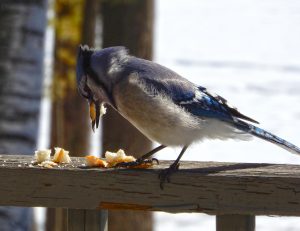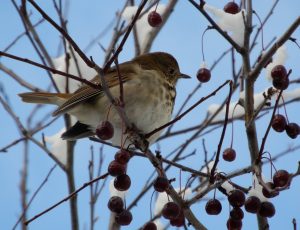Bulletin #7124, Bird Feeding Basics
Written by Extension Wildlife Specialist Catherine A. Elliott, Ph.D. Updated by David Fuller, Agriculture/Non-Timber Forest Products Professional, University of Maine Cooperative Extension.
Illustrations by Mark A. McCollough
For information about UMaine Extension programs and resources, visit extension.umaine.edu.
Find more of our publications and books at extension.umaine.edu/publications/.
Table of Contents
- Just pull up a chair and watch nature’s living works of art…
- Types of Feeders
- Types of Food
- Placing Feeders
- Provide Protection
- Other Offerings
- Sanitation
- Unwelcome Visitors
- A Final Word
- If I Stop Feeding, What Happens?
- Favorite Bird Foods
Just pull up a chair and watch nature’s living works of art…
Close your eyes for a moment and picture this ― a white carpet of new-fallen snow, the skeleton of a birch tree, and all around splashes of bright yellow, blue, red, and black. No, not abstract art. The color is provided by the goldfinches, cardinals, rose-breasted grosbeaks, and blue jays who have come to visit your feeder. An incredible work of nature’s art that can be just outside your door.
Feeding birds. It sounds simple enough. All you need to do is throw some seed on the ground, right? Well, yes, but there can be a bit more to it than that. If you are willing to put in a little time and effort, it can become a truly enjoyable pastime for naturalists of all ages. Most folks think of feeding birds in winter, but feeding birds can be an all-season activity. In fact, over 65 million Americans feed birds, spending over $3 billion a year on food and feeders.
Before you run out and buy a feeder and some seed, pause to think about what kinds of birds you want to attract. By choosing the right type of food, and putting it in the right type of feeder, you can increase your chances of attracting the birds you most want to see. Let’s look at some of the options.
Types of Feeders
There are five basic types of feeders. Each is suited to certain foods and attractive to certain birds. When making a choice, look for a feeder that is made of durable materials, has few moving parts, and is easy to fill and clean.
Tray feeders
This is simply an open platform on which you scatter a variety of foods, including seeds, nuts, fruits, and baked goods. They are used by ground feeding birds, such as juncos, doves, and sparrows, as well as many others. Having an edge or lip around the feeder will help keep the food from being kicked off onto the ground. Be sure the feeder has drain holes on the bottom so the food doesn’t stay wet and get moldy. If you make your own feeder, you can use a fine mesh screen on the bottom for even better drainage. It is best to put a small amount of food out at a time, to prevent spillage and waste, and to keep it from getting covered every time it snows! You can also put a roof over the feeder, leaving the sides open, to help keep the food dry. This is often referred to as a fly-through feeder.
Hopper feeders
Also know as bin feeders or self feeders, hopper feeders have a bin or reservoir above that dispenses seed onto a tray as the birds eat. The advantages with these are that they keep the food drier and need less frequent filling. Hopper feeders are used for seeds and nuts, attracting birds such as cardinals, purple finches, chickadees, juncos, and grosbeaks, among others. If blue jays keep emptying your hopper feeder, try a tube feeder.
Tube feeders
These feeders have openings or ports along their length where the birds perch to feed. Most types of seed can be offered from these feeders. Special tube feeders for offering niger seed to goldfinches have very small openings so that the tiny seeds don’t just pour out. Metal ports will reduce the amount of squirrel damage. Short perches will make it more difficult for large birds, such as blue jays and grackles, to use this type of feeder.
Basket feeders
There are many sizes and shapes of basket feeders, but they are mostly used for offering suet, peanuts in the shell, chunks of fruit, and other large food items. They range from a simple onion bag to more elaborate wire cages and baskets. Suet can also be melted and mixed with seeds, peanut butter, or cornmeal (see recipe). This mixture can be allowed to harden and offered in a basket feeder. An alternative is to pack it into 1-to 1 1/2 inch holes drilled into logs. Chickadees, woodpeckers, and nuthatches are the most common suet-eating birds. Peanuts are a good summer alternative to suet, which tends to go rancid. In the summer, an onion bag or basket of over-ripe fruit will attract fruit flies. If hung near a nectar feeder, hummingbirds will eat both the flies and the nectar.
Nectar feeders
In Maine, nectar feeders are used only in summer. Ruby-throated hummingbirds and Northern orioles are the most common visitors, but occasionally you may see a nuthatch, downy woodpecker, or Tennessee warbler. There are also nectar feeders for butterflies.
Hummingbird feeders are red and have small holes through which the birds sip the nectar. Oriole feeders are orange and have larger perches. The same nectar can be used in both feeders. To make you own nectar, just mix one part sugar and four parts boiled water, stirring until the sugar dissolves (for butterflies use one part sugar to eight parts water). Allow the mixture to cool before filling your feeders. There’s no need to add food coloring, there is enough color on the feeders themselves.
It is very important to clean nectar feeders and refill them with fresh solution every three or four days. This will prevent spoilage and the growth of black fungus.
Nectar feeders can be put out in late April to early May, and taken down in late September. Don’t worry that your feeders will keep hummingbirds from migrating; they will go when it is time.
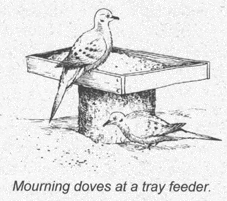
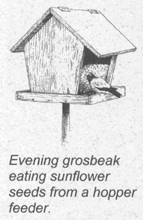
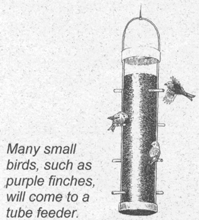
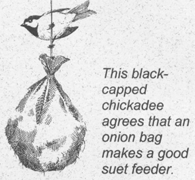
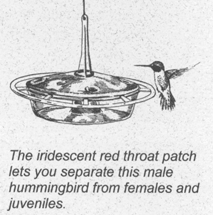
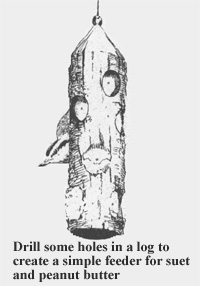
Types of Food
If you want to attract many different species of birds, you need to offer a variety of foods. Some birds will eat almost anything, most have favorite foods, and a few are very picky and will only eat one or two types. Refer to the Favorite Bird Foods to determine which foods to offer to attract your favorite birds. By choosing the right type of food, and putting it in the right type of feeder, you can increase your chances of attracting the birds you most want to see.
Black-oil sunflower
If you are only going to offer one type of food, this is the best choice. Over 40 species of bird will eat black-oil sunflower, and at least 14 species have it as one of their favorites. The shells are thinner than the grey-stripe sunflower, making it easier for the smaller birds to crack them open. The oil content of the seeds is over 40 percent, which means it’s a high-energy food. Be sure to clean up the hulls from under the feeder, and don’t put them on your garden, flower beds, or in the compost pile. The hulls contain a growth inhibitor that could keep your plants from growing. Sunflower kernels (removed from the hulls) are more expensive, but do cut down on the mess.
Peanuts
Peanuts can be offered in-the-shell, or as whole or broken kernels. Peanut hearts are often found in seed mixes, but most birds won’t eat them.
White proso millet
Although this is a favorite of many birds, it is also very attractive to house sparrows, who compete with local songbirds for nest sites, and brown-headed cowbirds, who lay their eggs in songbird’s nests. If these birds are common in your area, you might want to avoid white proso millet.
Niger seed
Also called thistle seed or niger thistle, it is the special favorite of American goldfinches. Niger seed is imported from Ethiopia and India. It is fairly expensive, especially if purchased in small quantities, so you might want to consider purchasing a large sack and splitting the cost with several friends. It is usually offered in a special feeder to reduce spillage and waste.
Safflower
An increasingly popular seed, safflower has the advantage that house sparrows, starlings, and squirrels don’t seem to like it. Give it a try.
Cracked corn
Readily available and fairly inexpensive, cracked corn is a common ingredient in mixes. A mix of white proso millet and cracked corn can be scattered on the ground in spring and fall to feed migrating sparrows, juncos, and other ground-feeding birds.
Shelled and ear corn
Many of the larger birds will readily eat whole corn. The main difficulty is that it is also a favorite of squirrels. Shelled corn can be offered in a hopper feeder, on a tray feeder, or on the ground. Ear corn can be offered on a tray feeder, on the ground, or in a cylinder made from wire fencing. Ear corn can be used to distract squirrels from your other feeders. Try stringing several ears together on a wire and hanging them from a branch, then watch the fun.
Suet
Rich in fat and protein, suet is easy to provide and fairly inexpensive, making it popular with birds and people alike. Ask your local butcher to save trimmings for you. Suet can be offered as is, or melted into cakes. Suet is also available in pre-formed cakes, either plain or mixed with seeds and or peanut butter.
Peanut butter
Whether you offer it straight from the jar or mixed with suet, seeds, or cornmeal, peanut butter is a high-energy, nutritious food. Try smearing it on the trunk of a tree or packing it into holes drilled into a log feeder. You can do the same with the peanut butter suet mix.
Peanut butter suet mix
You can form this mixture into blocks for a basket feeder or pack it into a pine cone or into holes drilled into a small log.
1 c. melted suet
1 c. peanut butter (smooth or crunchy)
1 c. flour
4 c. yellow cornmeal
Mix the suet and peanut butter, then add the flour and cornmeal. You may need to adjust the amount of cornmeal if the mixture is too sticky or too dry. For variety, try adding one or more of these:
1 c. sunflower chips
1 c. currants
1 c. chopped peanuts
Seed mixtures
There are many types of seed mixes available on the market. Before you buy, take a close look at the list of ingredients and decide if the mix is suited to the species of bird you want to attract. You should also consider using different mixes at different times of the year.
For example, you might use a mix that is mostly white proso millet, scattered on the ground in spring and fall for migrating birds, then switch to another mix in summer and winter. If you want to attract the greatest variety of birds, use a mix that is mostly black-oil sunflower.
Fresh and dried fruit
A variety of fruits can be offered throughout the year. Apples will attract gray catbirds, blue jays, and robins. Oranges, cut in half, are particularly attractive to Northern orioles, especially in early spring. Bananas, sliced length-wise, and watermelon, can be offered on a tray feeder to attract migrating spring warblers and tanagers. Raisins and currants are eaten by a variety of birds. Soaking them before putting them on the tray feeder will make them easier to eat.
Grape jelly
If you like Northern orioles and gray catbirds, try offering grape jelly in a small dish on a tray feeder. It’s easy.
Baked goods
Just about any type of baked good, from cookies to bread, doughnuts to crackers, can be offered, either scattered on the ground or placed on a tray feeder. The drawback with baked goods is that they are also a favorite of house sparrows and starlings.
Egg shells
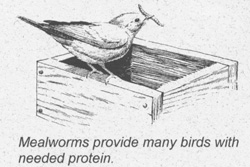
Egg shells that have been dried and crushed are a valuable nutrient supplement in the spring. Offered on tray feeders, the calcium will benefit many species of bird.
Mealworms
Fast becoming the latest thing in feeding birds, mealworms are the larvae of small black beetles that are usually found in stored grain. Many, many birds are attracted by them, maybe even more than black-oil sunflower. Place them on a tray feeder or in a small tray or dish.
Mealworms can be obtained from local pet stores, or you can try raising your own.
Placing Feeders
Where should you put your feeders? Each situation is a little different, and it may take some experimenting to figure out just where the best spots are. In fact, the best spots may be in different places at different times of the year! You want to be able to see the birds, so find a good vantage point and start there. You also want to consider ease of access for filling and cleaning. Another thing to consider is the “mess factor.” There will be seeds and hulls on the ground, and if the feeders are near windows or walls you may get the occasional white-wash to clean up. You can reduce the damage to vegetation under your feeders by regularly raking up the debris, which will also reduce the possibilities of disease.
Provide Protection
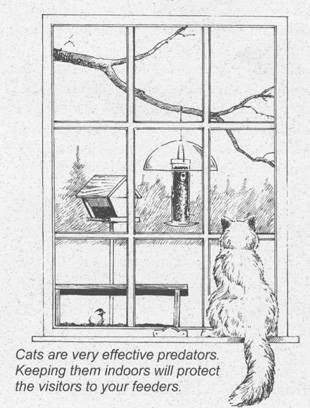
Protection from predators, both birds and mammals, is an important consideration. Along with the birds that come to eat at your feeders, you may attract predators such as hawks, owls, shrikes, the occasional weasel, and, most frequently, house cats.
Although it is sometimes hard to do, try to think of the predatory birds, also called raptors, as part of the natural cycle of things, and to enjoy the rare opportunity to see them close up. They are beautiful birds! When a raptor begins to visit your feeders, you will probably notice the other birds becoming more wary and elusive. After a few days, the raptor usually moves on. The same thing usually happens with weasels.
Cats, on the other hand, are extremely efficient hunters and can devastate local bird populations. Research at the University of Wisconsin has shown that house cats kill an estimated 19 million songbirds each year, in that state alone. Make sure your feeders are eight to 10 feet from nearby trees, bushes, or other hiding places where cats and raptors will wait in ambush. If you have a feeder or bird bath that is close to a bush or tree, circle the feeder or bath with two- by four-inch mesh wire fencing at least three feet tall to disrupt the approach of both cats and raptors. This will allow the birds to fly through the mesh or fly upward to escape. If you own a cat, consider keeping it indoors or on a leash when outdoors. Putting bells on a cat may help, but because they stalk and ambush, bells usually don’t make much difference. Feral cats can be live trapped and taken to the local animal shelter.
Nearby shrubs, trees, or even a fence, will also serve to break the wind. This is especially important in winter. Feeders in the open are often avoided by birds trying to conserve energy and stay warm in winter. A discarded Christmas tree can be used as a temporary shelter and windbreak.
Other Offerings
Water
All birds require water, both for drinking and for bathing. A bird bath, with sloping sides, a rough bottom, and no more than two or three inches deep, is ideal. An immersion heater can be used in winter to keep ice from forming. Keep bird baths clean and replace water often.
Grit
Birds need to have grit in their gizzards to help them grind up their food. Sand or finely crushed oyster or clam shell are fine. Crushed egg shells are also good and will provide extra calcium, especially in spring.
Natural foods
Are there fruits, seeds, nuts, flowers, nectar, and insects available in your gardens or in a nearby woodlands? If you are doing plantings, try to use a variety of plants that will provide food throughout the growing season and into the fall and winter.
Nesting sites
Trees, bushes, and shrubs will provide many natural nesting sites. You may want to consider artificial nest boxes for species such as bluebirds and swallows. Not only will you enjoy seeing these birds, they will also help control the local mosquito population.
Sanitation
It is important to clean your feeders regularly. In warm weather a mold can form on wet bird food that can cause a fatal avian disease called aspergillosis. Salmonella can also be associated with poorly maintained feeders. In addition, feeder openings can become clogged with accumulated dirt, stems, hulls, and droppings, making it difficult for the birds to get to the food.
Keeping the food dry is an important first step. This easiest with covered, hopper, and tube feeders. If you are using an open tray feeder, a screen bottom will allow the food to dry from both the top and bottom. Putting out small amounts of food at a time and scraping regularly will also help keep tray feeders clean.
All feeders should occasionally be emptied and cleaned, inside and out. Use a mild detergent and a scrub brush to clean all surfaces. One or two capfuls of bleach in a bucket of water can be used to disinfect feeders. Rinse thoroughly and allow to dry before refilling. If you can set them out in the sun to dry, the sunlight will help kill bacteria in the feeder.
Nectar feeders should receive special attention. The hotter the weather, the more often you should clean the feeder. During the summer, every three or four days is usually sufficient. After you empty the feeder, soak it in a bleach solution (the same dilution as for cleaning other feeders) for an hour before rinsing, drying, and refilling fresh sugar water. This will help prevent the growth of black fungus.
Unwelcome Visitors
The most common unwelcome visitors are squirrels. Although some folks enjoy their antics, they can be very destructive, eat large quantities of food, and prevent the birds from getting to the feeders. Baffles placed above or below feeders, and aluminum flashing wrapped around support posts are usually effective at repelling squirrels. A coating of grease or shortening may also help. Trim back overhanging tree branches to prevent squirrels from jumping from the tree to your feeder. Providing squirrels with their own food, such as a bucket of dried corn or ears of corn in a wire hopper, can sometimes decoy them away from other feeders. Live-trapping and shooting are options in some instances, but be sure to check local ordinances and regulations before doing so.
Raccoons may be attracted to your feeders, especially for suet, nectar, and sunflower seeds, but feeding raccoons should be discouraged. Raccoons are carriers of distemper and rabies, and their droppings can contain a parasitic roundworm that can be fatal to humans.
Baffles and flashing will help keep raccoons, as well as squirrels, from climbing support poles. Greasing poles will also help because raccoons don’t like getting grease on their fur. Hang suet and nectar feeders out of reach or on branches that are too slender to bear the weight of a raccoon. Trapping and shooting are also options for raccoons, but again, check local ordinances and regulations.
A Final Word
Whether you simply scatter some food on the ground, or build an elaborate feeding station, the most important thing is to sit back and enjoy! A bird book will help you identify the visitors to your feeders and binoculars will give you a closer look, but neither is really necessary. Just pull up a chair and watch nature’s living works of art!
If I Stop Feeding, What Happens?
Many folks don’t feed birds because they are concerned that the birds will become dependent on the feeders for survival and if they stop, for whatever reason, the birds will starve to death. To a large extent this is not so. Feeders serve as supplements to natural food sources, not replacements. Birds that visit feeders develop a routine or pattern of visiting feeders. If yours is empty on a particular day, they simply go on to the next. If your feeder remains empty for a long period of time, they may quit coming at all or just stop by once in a while to check it out.
The most critical time to have food available is during snow storms, ice storms, and periods of severe, prolonged cold. This is when it is most difficult for the birds to find natural foods, and your feeder can make a difference in the survival of a bird.
Favorite Bird Foods
Black-oil sunflower
American goldfinch, blue jay, brown thrasher, Northern cardinal, chickadees, evening grosbeak, house finch, mourning dove, pine siskin, purple finch, common grackle, red-breasted nuthatch, tufted titmouse, white-throated sparrow, song sparrow, dark-eyed junco.
White proso millet
Northern cardinal, brown-headed cowbird, chipping sparrow, dark-eyed junco, field sparrow, house sparrow, mourning dove, red-winged blackbird, rufous-sided towhee, song sparrow, tree sparrow, white-throated sparrow.
Red proso millet
Brown-headed cowbird, chipping sparrow, dark-eyed junco, field sparrow, house sparrow, mourning dove, red-winged blackbird, song sparrow, tree sparrow, white-throated sparrow.
Niger seed
American goldfinch, house finch, purple finch, redpoll, mourning dove, song sparrow, dark-eyed junco, white-throated sparrow
Peanut kernels and peanuts in the shell
Blue jay, chickadees, tufted titmouse, white-throated sparrow, downy and hairy woodpeckers, Northern cardinal, purple finch, evening grosbeak, dark-eyed junco, nuthatches.
Cracked corn
Common grackle, dark-eyed junco, European starling, red-winged blackbird, indigo bunting, Northern cardinal, crow, mourning dove, purple finch, rose-breasted grosbeak, blue jay, sparrows.
Suet
Chickadees, woodpeckers, nuthatches.
Sugar Water
Ruby-throated hummingbird, Northern oriole (also grape juice and grape jelly), Tennessee warbler, nuthatches, downy woodpecker, butterflies.
Fresh fruit
Northern oriole, scarlet tanager, some woodpeckers, gray catbird, American robin, blue jay, some warblers.
Dried fruit
American robin, cedar waxwing, Eastern bluebird, gray catbird, Northern mockingbird, brown thrasher, Northern cardinal.
Baked goods
Red-winged blackbird, Northern cardinal, gray catbird, chickadees, brown creeper, pigeon, grackle, blue jay, dark-eyed junco, Northern mockingbird, white-breasted nuthatch, raven, American robin, sparrows, European starling, tufted titmouse, rufous-sided towhee, some warblers, some woodpeckers, Eastern bluebird, Northern oriole.
Information in this publication is provided purely for educational purposes. No responsibility is assumed for any problems associated with the use of products or services mentioned. No endorsement of products or companies is intended, nor is criticism of unnamed products or companies implied.
© 2000, 2017
Call 800.287.0274 (in Maine), or 207.581.3188, for information on publications and program offerings from University of Maine Cooperative Extension, or visit extension.umaine.edu.
In complying with the letter and spirit of applicable laws and pursuing its own goals of diversity, the University of Maine System does not discriminate on the grounds of race, color, religion, sex, sexual orientation, transgender status, gender, gender identity or expression, ethnicity, national origin, citizenship status, familial status, ancestry, age, disability physical or mental, genetic information, or veterans or military status in employment, education, and all other programs and activities. The University provides reasonable accommodations to qualified individuals with disabilities upon request. The following person has been designated to handle inquiries regarding non-discrimination policies: Director of Equal Opportunity, 5713 Chadbourne Hall, Room 412, University of Maine, Orono, ME 04469-5713, 207.581.1226, TTY 711 (Maine Relay System).


